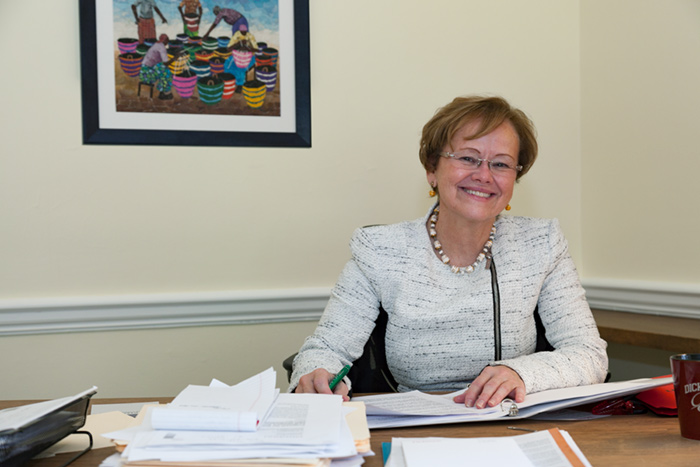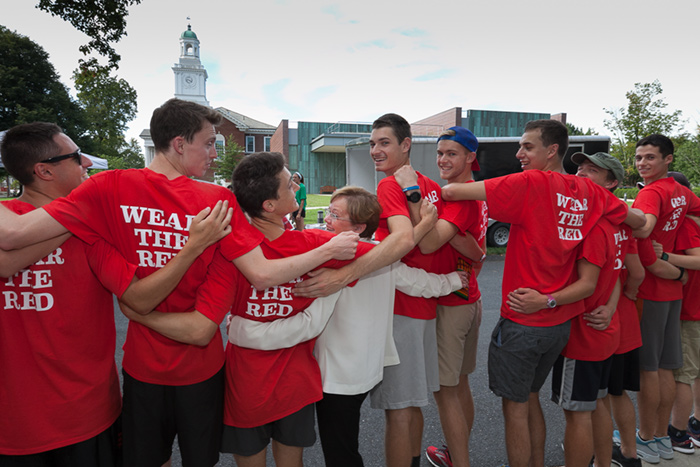A Visible Spark

Photo by Carl Socolow ’77
edited by Lauren Davidson; photos by Carl Socolow '77
Her energy is infectious, and her laugh is a full-body experience. Her presence is an inextricable mix of warmth and savvy, of curiosity and immense knowledge, of leadership and collegiality. Since Ensign stepped into the role of Dickinson’s 29th president—made official on July 1, though she was hard at work well before then—that presence has been felt on campus as she welcomed generations of Dickinsonians during Alumni Weekend and a new generation during Orientation. It has been felt in Carlisle as she spoke during a peace rally and opened her home to engage with community leaders. It has been felt on the road as she's met with trustees, donors and friends of the college, sharing her vision and her ideas to propel Dickinson forward.
Like Dickinson’s founder, Benjamin Rush, Ensign is an idealist, and her arrival and emphasis on meaningful action, on a useful education for the common good, have sparked great buzz throughout the community. We know there is much more to come, and the following pages offer just a glimpse into her first four months in office and her responses to questions submitted by members of the Dickinson community.
I’m so honored to be in this community, to be home—to be home to a country that believes in peace, justice and equality, and that’s what we stand for. I pledge our support, our coordination and our partnership. This is an amazing community. ... I think we can be a powerful national model.
—speaking during the Carlisle Call for Unity gathering in August
On Dickinson
What’s your favorite spot on campus? —Maggie McConney ’21
The red chairs on the grass outside Old West. I can see from my office how they are so often rearranged for classes, for students to connect with one another and for solitary study, which is a perfect metaphor for our flexibility as an institution. And they so beautifully dot that picturesque space with our Dickinson red!
How will you make yourself accessible to students, both in groups and one-on-one? —Anh Pham ’21
I have already met with many students and student groups, attended athletic events and taught in several classes. I will continue to do this as well as start weekly office hours for students in October.
How do you plan to create a more welcoming environment for people of color this year? —Andres Salazar ’21
Dickinson has just welcomed its most diverse class in its history. This is something we should all celebrate. As you may know we have recently launched a new initiative to make sure we all have the knowledge and skills to deal with diversity and varied cultural context. I quote from a Huffington Post blog that I wrote on this topic:
“Our university campuses are already enormously diverse places. But simply drawing many sorts of people to one institution (and sending them off to study in the rest of the world, too) is only the very beginning of the cross-cultural educational process. Proximity isn’t enough, obviously. We all begin to self-sort, to find people like ourselves, to avoid others—all aided and abetted, of course, by the ubiquitous internet. Who among us is immune to this?
We must self-consciously and consistently teach and adopt those proven techniques which foster greater cross-cultural understanding and empathy. We must find the time and resources—not just the odd diversity workshop—to teach intercultural skills. It is a process, for everyone, of the most profound and often painful self-exploration. It is the fundamental responsibility of every college and university.”
Life at the American University of Nigeria involved Chibok girls escaping Boko Haram terrorism, their need just to survive and a hope for education. How challenging might it be to relate to Dickinson students with such a different life? —Eileen Fair Durgin ’52
While we were fortunate to be able to educate 24 of the Chibok students who escaped from Boko Haram, the university had a full undergraduate college as well as a law school and graduate programs. Students came from all over the continent and some came from the United States. Like American students, the predominantly African students want a world-class education preparing them for their futures. While there are differences of geography and culture, they all share a passion for American education.

On Higher Education
It is generally recognized that costs in the higher education system are out of control and that student debt is a bubble about to burst. How do you see higher education changing to reduce the debt load on graduates relative to their earning potential, and what do you plan to do at Dickinson to make a liberal-arts education accessible without significantly affecting the finances of students and/or families? —Steve Introcaso ’84
Increasing costs are a concern to everyone in higher education, and Dickinson has a task force focused on exactly these issues. We expect to have a report from that task force next spring, which will guide us in our decisions on cost and access. Dickinson has, however, always been very generous with financial aid and cautious with increases in tuition and fees, and our students graduate with an average loan debt that is consistently below the national norm.
Having spent my career in college admissions, having five granddaughters who have gone through the enrollment process and being someone who is always interested in enrollment trends, I have noticed that many colleges and universities have more women than men in their student bodies. Is there concern about how smaller male enrollment affects co-curricular activities, namely athletics? What steps will you take to influence this trend? —Joe Carver ’59
It is true that since the late 1970s, fewer men are going to colleges and universities (in the U.S.). I am not sure we have all of the answers as to why this is happening, but our responsibility is to make sure that our academic programs will prepare graduates for life in the 21st century and that there is a range of activities—clubs, sports, service opportunities—so that all Dickinson students have the opportunity to participate in something they enjoy.
Exploring new ideas and listening to others who challenge our beliefs and values is at the heart of academic life. This helps us to learn, to find answers to pressing problems and to become effective citizens of the world. There is no place in a college for closed-mindedness. The world is not a safe space, and any true engagement with the real world makes that immediately clear.
—from July 2017 op-ed in The Chronicle of Higher Education
On a Personal Note
What is your favorite travel spot? What about your “bucket list” travel spot? —Kirsten Nixa Sabia ’92
I have many favorite spots—most are in East Africa and many are on my bucket list, including Thailand, Nepal, Brazil and India.
Who has been your most inspiring or influential teacher or mentor, and why? —Angela Wallis ’02
I am fortunate to have had many inspiring mentors in my life—my parents, who allowed me to be independent and follow my dreams; a professor at New College, where I did my undergraduate work, who helped me learn to write and think critically and introduced me to international relations and African history; and the former president of Tulane University, who coached and mentored me through my period as a dean and president at AUN. They challenged me, were honest with my shortcomings, but always provided support.
Ensign will share additional responses to submitted questions in the winter issue, and you can pose questions in person at one of several events throughout the coming months (details at dickinson.edu/presidenttour).
Read more from the fall 2017 issue of Dickinson Magazine.
TAKE THE NEXT STEPS
Published November 3, 2017